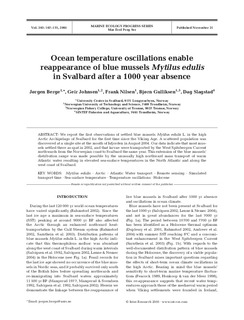| dc.contributor.author | Berge, Jørgen | |
| dc.contributor.author | Johnsen, Geir | |
| dc.contributor.author | Nilsen, Frank | |
| dc.contributor.author | Gulliksen, Bjørn | |
| dc.contributor.author | Slagstad, Dag | |
| dc.date.accessioned | 2011-11-24T14:25:22Z | |
| dc.date.available | 2011-11-24T14:25:22Z | |
| dc.date.issued | 2005-11-21 | |
| dc.identifier.issn | 0171-8630 | |
| dc.identifier.issn | 1616-1599 | |
| dc.identifier.uri | http://hdl.handle.net/11250/108780 | |
| dc.description.abstract | We report the first observations of settled blue mussels Mytilus edulis L. in the high Arctic archipelago of Svalbard for the first time since the Viking Age. A scattered population was discovered at a single site at the mouth of Isfjorden in August 2004. Our data indicate that most mussels settled there as spat in 2002, and that larvae were transported by the West Spitsbergen Current northwards from the Norwegian coast to Svalbard the same year. This extension of the blue mussels’ distribution range was made possible by the unusually high northward mass transport of warm Atlantic water resulting in elevated sea-surface temperatures in the North Atlantic and along the west coast of Svalbard. | no_NO |
| dc.language.iso | eng | no_NO |
| dc.publisher | Inter-Research | no_NO |
| dc.subject | blue mussels | no_NO |
| dc.subject | blåskjell | no_NO |
| dc.subject | temperature | no_NO |
| dc.subject | temperatur | no_NO |
| dc.subject | Arctic | no_NO |
| dc.subject | Arktis | no_NO |
| dc.title | Ocean temperature oscillations enable reappearance of blue mussels Mytilus edulis in Svalbard after a 1000 year absence | no_NO |
| dc.type | Journal article | no_NO |
| dc.type | Peer reviewed | no_NO |
| dc.subject.nsi | VDP::Mathematics and natural science: 400::Zoology and botany: 480::Marine biology: 497 | no_NO |
| dc.source.pagenumber | 167-175 | no_NO |
| dc.source.volume | 303 | no_NO |
| dc.source.journal | Marine Ecology Progress Series | no_NO |
| dc.identifier.doi | http://dx.doi.org/10.3354/meps303167 | |
